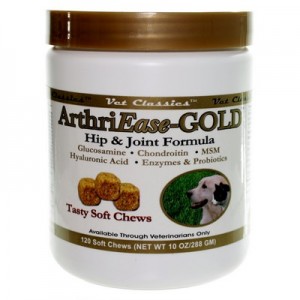
Arthritis is one of the most common diseases on the planet, as there are over 100 different forms of it in nearly all vertebrates. (Even the dinosaurs had it!) Although more prevalent in the elderly, animals of any age can suffer from this degenerative disorder that attacks the joints. This includes our pets. A significant number of cats and dogs are afflicted with arthritis. Because they are generally larger, dogs are more likely to be diagnosed than cats.
What is osteoarthritis?
The most common form of the condition, osteoarthritis strikes one in five dogs during their lifetime. While older pouches are disproportionately affected, it is not at all uncommon for a younger dog to develop the disorder if he has a preexisting condition. This includes joint trauma, patella luxation, ruptured ligaments, hip dysplasia, and other issues that affect the joints and can precipitate degenerative arthritis.
Because they are heavier, large-breed dogs are more likely to be diagnosed with osteoarthritis than small dogs. Overweight and obese dogs of any size are also at an elevated risk of the disease, since the extra weight puts added stress and strain on their joints.
Symptoms of Osteoarthritis in Pets
Like other degenerative diseases, osteoarthritis tends to get worse with age. Dogs with the disorder suffer varying degrees of joint pain, stiffness, and lameness that is generally more severe during the early morning hours or after arising from a nap. Cold and damp weather can also exacerbate the symptoms, making it painful for your pet to perambulate. As a result, dogs with the disease may experience behavioral changes such as increased irritability and anger. Depression is another symptom animals immobilized by arthritis may suffer from.
Causes of Osteoarthritis in Pets
The primary cause of osteoarthritis is unknown. But as we mentioned, we do know that secondary causes like trauma and birth defects can expedite joint degeneration in dogs of any age. Obesity can also exacerbate preexisting conditions, causing further complications.
Diagnosis of Osteoarthritis in Pets
The only surefire way to diagnose the disorder is with x-rays. Your dog’s doctor will then examine the areas around the joint for bone spurs where the ligaments attach to the bone. In most cases of advanced osteoarthritis, narrowing joint space and greater bone density around the joint are apparent on x-rays.
Treatment of Osteoarthritis in Pets
There is no known cure for osteoarthritis, which is why treatment is limited to pain management. The goal is to alleviate the most uncomfortable and aggressive symptoms of the disorder, thereby improving your dog’s quality of life. A combination of physical therapy, weight control, and certain corticosteroids and analgesics can work wonders for most pets. Not only should they relieve pain, but these treatments may also improve limb function. There is even evidence that some medications can help repair joint cartilage and prevent further injury.
Another treatment method that some dog owners swear by is acupuncture. Just as it does in human subjects, the therapy may help relieve joint stiffness and pain, at least temporarily. So if you pet doesn’t mind being poked and pressed, acupuncture is an option.
As for physical therapy, studies have shown that moderate exercise is beneficial. Regular activity helps arthritic dogs maintain muscle mass and improve joint flexibility. Extreme exercise, however, can be harmful. Running, jumping, and standing on their hind legs are activities that can easily exacerbate osteoarthritis. It is for this reason that dogs with lameness or mobility issues should only ever be exercised on a leash.
Management of Osteoarthritis in Pets
If your furry friend is overweight or obese, he really must lose weight. Being heavy further complicates any treatment plan for osteoarthritis. Not only does it intensify the symptoms, it makes it less likely that your animal will be up for exercise. Ask your veterinarian to recommend a diet plan for your dog. Take it slow and make sure your pet is getting enough to eat. But don’t let him snack in between meals and stop feeding him from the table! Keep in mind that being overweight can lead to other diseases for your pooch, including diabetes.
Painful arthritis flare-ups can often be managed with anti-inflammatory drugs. You can also use cold and heat therapy to reduce joint swelling and pain. A heating pad on a cold days should do the trick and help reduce stiffness. There are also a number of effective supplements that are sold over the counter.
Phycox Joint Support for Dogs
A safe and natural nutritional supplement, Phycox promotes bone health and joint mobility in dogs. Available in three formulations—small bites, granules, and soft chewables—the supplement contains phycocyanin, a natural anti-inflammatory, as well as healthy antioxidants and Omega-3 fatty acids. Although it a non-prescription medication, you should consult your dog’s doctor before administering Phycox. Also be sure to select the right dosage size based on your pet’s weight. To read about other options, check out our post How to Control Arthritis Pain in Dogs.








